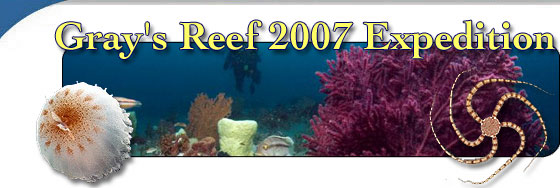Mission Log: June 12, 2007
Dave Grenda
Reef Environmental Education Foundation (REEF)
 | | Grenda |
The Nancy Foster, her crew, and the visiting science team of 13 left the Savannah dock at 0900. Skies were overcast, but otherwise great weather (warm & calm). A scientific meeting was held at 9:30 a.m. to introduce all participants, discuss science objectives, and cover ship procedures.
En route to J-Reef, engineers worked on the ship’s generators which caused some power interruptions – as Greg McFall found out, not the best time to download files over the ship’s Internet.
At 2 p.m. dive vessels NF-4 (with Gleason, Ruzicka, Shopmeyer, & Harbin aboard) and NF-2 (with McFall, Noakes, & Grenda aboard) were deployed for two dives on J-Reef. Diving depths were 60-70’ along a low profile ledge. The water was a balmy 77 degrees but the visibility was less than optimum – perhaps 6’. Fish counts, wide angle photography, and collection of fossilized whale bones were accomplished by the NF-2 dive trio. The intrepid foursome from NF-4 calibrated their benthic invertebrate survey techniques so they could conduct their data collection during rest of the cruise. Both diving vessels were recovered at 4:30 p.m.
As the skies cleared, The Nancy Foster sailed to Pirate’s Point to drop off a crewmember before heading back to GRNMS. At 7:30 p.m. a Conductivity Temperature Depth (CDT) cast was accomplished – this is a procedure to calibrate the Multibeam sensor for the water conditions it will encounter. Once that was accomplished, Paul Gayes and his team deployed Compressed High Intensity Radar Pulse (CHIRP) and Multibeam sensors to conduct geophysical surveys of the GRNMS. The team obtained detailed measurements of the GRNMS sea bottom. The Nancy Foster conducted data collection transects all night long with CHIRP and Multibeam. Science never sleeps.
I consider myself very fortunate to participate on this interesting cruise. I was invited aboard because of my extensive REEF fish surveying experience. Any recreational diver can learn to identify fish and then conduct REEF fish surveys during their dives. It’s a way to “give back” and at the same time enhance your dive experience. Learn about REEF and becoming a Citizen Scientist by visiting www.reef.org
|



